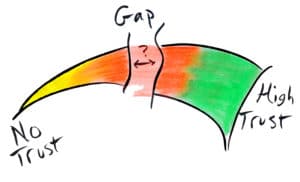How to Win Your Prospects’ Trust
why is there a niche problem in the first place? it has to do with how people’s brains and attention spans work. in this “From Impossible” excerpt, i talk about the Arc of Attention and the Trust Gap: two vital aspects key to understanding the niche problem and what to do about it.
The Arc of Attention
When starting a business, most people begin with Early Adopters: networks, friends, friends-of-friends, and people who instinctively “get it”. Once you hit $1M-$10M in revenue, you usually hit the wall as word-of-mouth and referrals start to plateau (or, as a large company, when your new leadgen program, product launch, or market struggles). At some point you run out of Early Adopters and need to figure out how to click with Mainstream Buyers’ people who don’t already know you and don’t intuitively “get it” like Early Adopters.
There’s a painful difference to evolve from selling to Early Adopters who trust you, to Mainstream Buyers who don’t. Geoff Moore called this Crossing The Chasm. We call it bridging a Trust Gap. Whatever it’s called, when you understand why this gap exists in the first place, you’ll better know how to cross it.

The Right Side – High Trust
On the right side of the spectrum are “Mom/Dad /Best Friends” – people who know and trust us (or your company/brand), and are willing to give you a big slice of attention just because you asked for it.
If you call up a best friend and ask them to meet with you for two hours to review a demo, product, blog post or talk, they will – even if it makes zero sense to them.
This side of the arc also includes the few people who somehow run across your product, as crappy or obtuse as your website is – and just “get it”. You don’t need to explain anything to them, because intuitively they know what you can do, why it matters and how to use you service.
All of these Early Adopters are willing to invest a lot more mental energy to figure out what you’re doing and how they can benefit. They give you a lot of leeway – which is invaluable in getting a new company, product or leadgen program off the ground. But it becomes a liability – and often a rude awakening – when you start expecting everyone to give you that same leeway.
The Left Side – No Trust
On the opposite end, there are the people who have never heard of you or your company. When people don’t know you, they’ll only give you a tiny sliver of their attention to figure you out. If they don’t click with you within that window, they move on.
The more connection you have with them right away, the more leeway they’ll give you. The less you have, the faster you lose them. Some sample (non-scientific) windows:
- A cold email or online ad: a 0.3 to 3-second window before they engage or move on.
- A cold call: a 3- to 30-second window.
- Walking door-to-door: a 3- to 60-second window.
Compare these to:
- A referral: 15 minutes – 1 hour
- A best friend or parent: Unlimited
Bridging the Trust Gap
The whole point of Nailing A Niche is to help you move from depending on buyers on the right side (Trust) to being able to better market and sell to buyers on left side (No Trust). You have to either find a way to fit your message into that slice of attention, or expand the amount of attention they’re willing to give you.
The tiny slices of attention that “cold” people are willing to give you are the mental investments equal to those of 3rd or 4th graders. Your message has to be simple for them to both understand and easily act on, or else they’ll move on before ever giving it a chance.
You can watch this in yourself: what goes through your head when you get a long note from someone, even someone you know? What about a short one? Do you see how the effort you’re willing to give that messages changes so dramatically depending on who it comes from, how simple it is, and what they are asking for?
This is why “short and sweet” emails and videos tend to work better than long emails and videos as first touches with new people. People see a long email or video from someone they don’t know, and they just aren’t willing to invest in consuming it.
If you’re a genius copywriter, maybe you can make them work, but for us regular people, shorter is better – at least for first contact. The simpler your messages are to understand and answer, the more easily they’ll fit into your prospects’ window of attention.
Read more: Achieve World Domination One Niche At A Time